|
Belgium’s Artisanal Lacework Endangered (No.44)
21 February 2014
Living in Brussels I am concerned about the many beggars on the streets. There are almost always poorly-dressed beggars at the main intersections walking between the rows of cars which have come to a stop at the traffic lights, begging for pocket change with an empty can in their hands. During the winter however you seldom see people handing over money as many drivers keep their car windows closed, but nevertheless, during the morning rush the same people beg for money on the same spot every day. According to the local newspapers, two thirds of them are Roma gypsies from Romania. Through a legal reform 20 years ago it is impossible to prohibit begging on the streets in Belgium, but it is however possible to prohibit begging at specific places and certain days (such as Sundays and Holidays) by ordinance of the city and administrative district and to crack down on persistent beggars and beggars taking along an infant for a long period of time. In certain parts of Brussels the ordinance says to restrict the number of beggars to three people per street. According to the same source, such beggars get 16 to 17 euro per day. Also, at certain intersections, some young students of circus schools perform circus acts as soon as the traffic light turns red, juggling with props such as balls and sticks on the zebra-crossing to receive some money. This to me is very strange as such scenes are not seen in Japanese cities such as Tokyo. When I asked Belgians how they felt about this, they said that “every morning we need to face these qualms of our conscience and it does not feel good”.
< History and Current Situation of Belgian Handmade Lace >
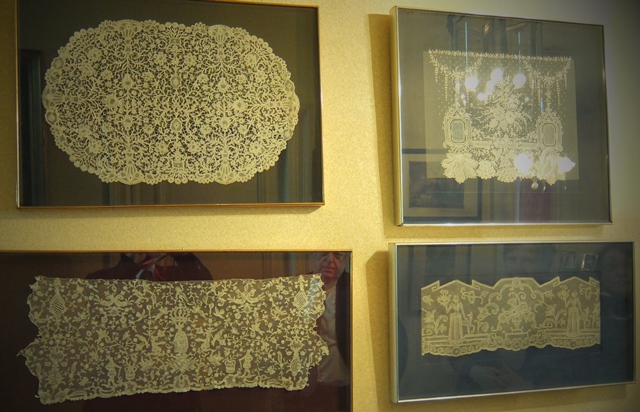 If the first souvenir that foreigners travelling in Belgium buy is chocolate, the second one is probably lacework. Especially, it is amazing that there are so many souvenir lace shops at the Grand Place, a worldwide sightseeing spot in the centre of Brussels. However, most of them are made in China, mixed with a few Indian and Sri Lanka lace products. In addition, most of them are made by machine. There is hardly any handmade lacework. In short, except for a few cases, Belgian handmade lacework is disappearing from the market. If the first souvenir that foreigners travelling in Belgium buy is chocolate, the second one is probably lacework. Especially, it is amazing that there are so many souvenir lace shops at the Grand Place, a worldwide sightseeing spot in the centre of Brussels. However, most of them are made in China, mixed with a few Indian and Sri Lanka lace products. In addition, most of them are made by machine. There is hardly any handmade lacework. In short, except for a few cases, Belgian handmade lacework is disappearing from the market.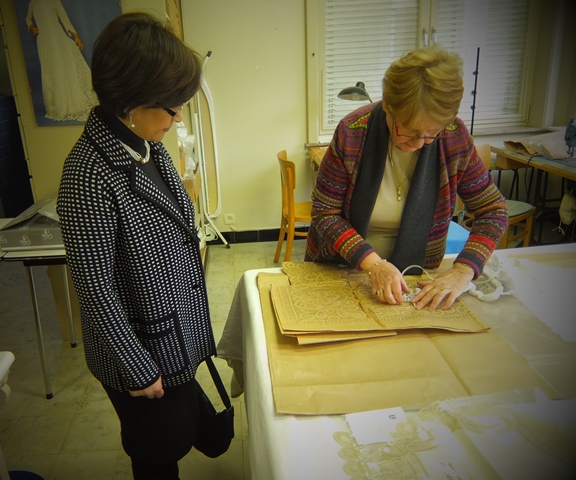
The other day, I visited the house of a Belgian elderly woman living in Aalst (30 km west of Brussels: 80.000 inhabitants) and received a tour in the atelier where high-quality handmade laceworks have been made since the generation of her great-grand father. The production of handmade lace started in the 15th century in Flanders and had developed to a big traditional industry with about 2000 employees in the days of her grand-father. However, the import of Chinese products gradually started in the 20th century. When the machine-woven lace techniques became widely used, Belgian handmade lacework, which is costly and labour-and time-consuming, rapidly disappeared from the market. For a square metre of very elaborate lacework, it would take a single person 100 years to weave. Therefore, handmade lacework cannot keep up with cheap machine-produced lacework. Some of the laceworks I was shown at the home of this Belgian lady were made about 200 years ago. The beauty and delicacy of design truly make them works of art. The reality is that now, without people to pass on these techniques, only a handful of women are studying these traditional techniques in hobby classes. Belgian hand-made lacework is on the verge of extinction for sure.
< Antwerp: A Global Centre of Fashion >
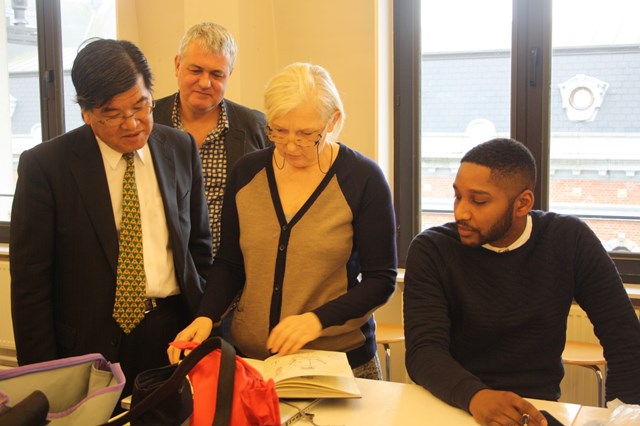 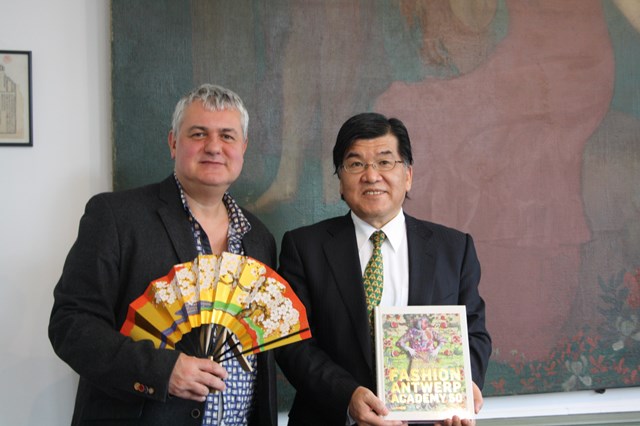 Antwerp is now, besides known for its diamonds also renowned for it being a global centre of fashion. On the main street in the centre of town, there are many famous fashion designers’ stores. The other day, I visited the Royal Academy of Fine Arts in Antwerp where I met with Dean Eric Ubben and heard an interesting story about the secrets of today’s prosperity. This academy was founded in 1663 as the succession of the artists’ guild. Its 350 years anniversary was celebrated last year. Also Vincent van Gogh attended the academy for a very short period of time at the end of the 19th century. It was 50 years ago that the Fashion Department was established and 150 students, (85% are international students) which corresponds to 30% of the overall 500 students, are studying at the Fashion Department. Of the nine Japanese students at the academy, six are fashion students. This department is known for its difficulty to advance to the next year. Only 40 to 50% of the students in each grade are able to push through, so many students drop out halfway. Two Japanese students whom I happened to meet in the school told me it was indeed very hard to pass. This strict educational environment is one of the secrets to create excellent designers, and at the same time, Antwerp with its once flourishing tradition in the textile industry and its unique living space of a middle-sized international city, provides a favourable environment for concentrating on one’s studies. The Royal Academy of Fine Arts, which brought forth in the 1980’s up-and-coming designers such as Dries Van Noten and others, called the “Antwerp Six”, is now mentioned in the same breath as famous fashion schools in New York and London. It makes Antwerp even more glamorous. Antwerp is now, besides known for its diamonds also renowned for it being a global centre of fashion. On the main street in the centre of town, there are many famous fashion designers’ stores. The other day, I visited the Royal Academy of Fine Arts in Antwerp where I met with Dean Eric Ubben and heard an interesting story about the secrets of today’s prosperity. This academy was founded in 1663 as the succession of the artists’ guild. Its 350 years anniversary was celebrated last year. Also Vincent van Gogh attended the academy for a very short period of time at the end of the 19th century. It was 50 years ago that the Fashion Department was established and 150 students, (85% are international students) which corresponds to 30% of the overall 500 students, are studying at the Fashion Department. Of the nine Japanese students at the academy, six are fashion students. This department is known for its difficulty to advance to the next year. Only 40 to 50% of the students in each grade are able to push through, so many students drop out halfway. Two Japanese students whom I happened to meet in the school told me it was indeed very hard to pass. This strict educational environment is one of the secrets to create excellent designers, and at the same time, Antwerp with its once flourishing tradition in the textile industry and its unique living space of a middle-sized international city, provides a favourable environment for concentrating on one’s studies. The Royal Academy of Fine Arts, which brought forth in the 1980’s up-and-coming designers such as Dries Van Noten and others, called the “Antwerp Six”, is now mentioned in the same breath as famous fashion schools in New York and London. It makes Antwerp even more glamorous.
< Belgium’s Chocolate Fair >
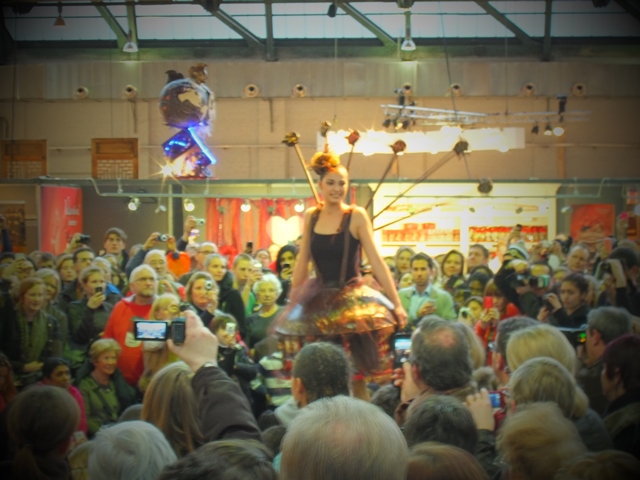 At the beginning of this month, the first ever Chocolate Fair (Salon des Chocolats) in Belgium was held at an expo centre in Brussels. The event was hosted by the French company Event International, who organised already identical events in the U.S.A. and Japan, but this fair was held in Belgium for the first time. At the fair about a hundred famous chocolate brand names from France and Belgium sold their chocolate at their booths. The weekend I visited the venue was packed with families with children and groups of women. It was a great success. The showstopper was the chocolate dress fashion show. The stage was surrounded by a tremendous crowd to the extent that most of the people could only see the top-half of the models. Luckily enough I could go backstage under the guidance of the hosts and see the show from the backside. It appeared to be the same case for other guests as well. Upon entering the backstage area I had the chance to greet Minister of Foreign Affairs Didier Reynders and former President of the Senate Armand de Decker in this unusual place. After the show we visited the fair together and got to taste a lot of chocolates. At the beginning of this month, the first ever Chocolate Fair (Salon des Chocolats) in Belgium was held at an expo centre in Brussels. The event was hosted by the French company Event International, who organised already identical events in the U.S.A. and Japan, but this fair was held in Belgium for the first time. At the fair about a hundred famous chocolate brand names from France and Belgium sold their chocolate at their booths. The weekend I visited the venue was packed with families with children and groups of women. It was a great success. The showstopper was the chocolate dress fashion show. The stage was surrounded by a tremendous crowd to the extent that most of the people could only see the top-half of the models. Luckily enough I could go backstage under the guidance of the hosts and see the show from the backside. It appeared to be the same case for other guests as well. Upon entering the backstage area I had the chance to greet Minister of Foreign Affairs Didier Reynders and former President of the Senate Armand de Decker in this unusual place. After the show we visited the fair together and got to taste a lot of chocolates.
The chocolate industry in this country is so famous that when you say Belgium, beer or chocolate come to mind, but looking at the consumption of chocolate per capita it is no more than 7.3 kg per year. This falls far short of that of countries as Switzerland, Germany and the U.K. In fact, 450.000 tons, which is 62% of the annually produced 730.000 tons, is exported. There are 498 companies in the industry with only a mere 6000 employees and the annual sales amount to 4.1 billion euro. The change in capital relations in this sector, however, is quite fierce; looking at Godiva (established in 1926), a representative of Belgian chocolate, it was bought in 1966 by American Campbell and later resold in 2007 to the Turkish Ulker Group. Other examples include Côte d’Or which was brought under the capital of the Swiss Jacobs Suchard in 1987, Galler, which is in the hands of the royal family business in Qatar since 2006, and Guylian, famous for its seashell-shaped chocolates, which was bought by Korean Lotte in 2008. On the surface it may look like a glamorous world, but is very hard to survive in the very competitive industry.
< Brueghel’s Mysteries >
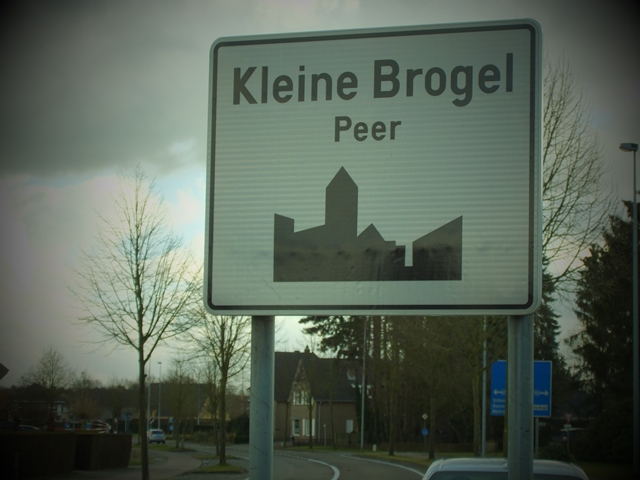 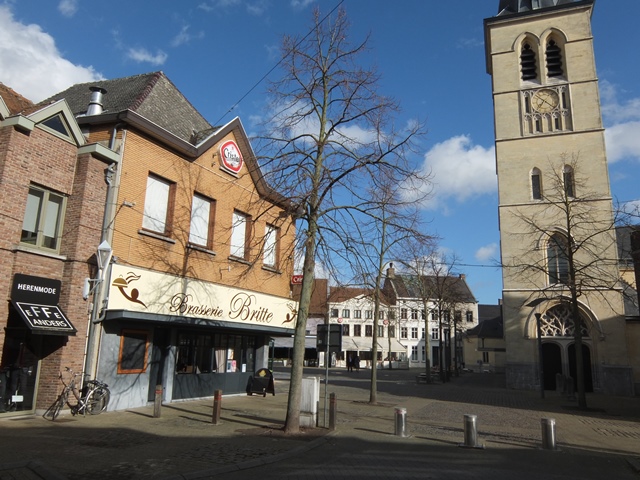 In the Museum of Fine Arts in Brussels there are several works of Pieter Brueghel on display. If you have even the slightest interest in European art, you must have heard of the 16th century Flemish master Pieter Brueghel the Elder. Especially his “The Hunters in the Snow” is very famous and is used in Japanese school textbooks as well. Even people who have no interest in art will probably go: “Ah, so this is the person who painted that!” when they see the painting. By the way, it is rare to find a painter who is such a mystery as Pieter Brueghel. First of all, his year of birth is not clearly documented. Even though no-one disagrees on 1569 being the year of his death, the place and cause of death are unknown. The paintings themselves do not just portray simple scenes as the “Peasant Painter” would suggest. From the Catholic point of view it was a heresy and from the fact that he also revolted against the Spanish rule, even one landscape may look deceptively simple, but contains many allegories, giving birth to various interpretations. Furthermore, to complicate things even more, Pieter Brueghel’s eldest son bears the exact same name and on top of being a well-known painter himself, he has left several imitations of his father’s works. “Landscape with the Fall of Icarus” which is part of the collection of the Brussels’ Royal Museum of Fine Arts is nowadays regarded as a fake. In the Museum of Fine Arts in Brussels there are several works of Pieter Brueghel on display. If you have even the slightest interest in European art, you must have heard of the 16th century Flemish master Pieter Brueghel the Elder. Especially his “The Hunters in the Snow” is very famous and is used in Japanese school textbooks as well. Even people who have no interest in art will probably go: “Ah, so this is the person who painted that!” when they see the painting. By the way, it is rare to find a painter who is such a mystery as Pieter Brueghel. First of all, his year of birth is not clearly documented. Even though no-one disagrees on 1569 being the year of his death, the place and cause of death are unknown. The paintings themselves do not just portray simple scenes as the “Peasant Painter” would suggest. From the Catholic point of view it was a heresy and from the fact that he also revolted against the Spanish rule, even one landscape may look deceptively simple, but contains many allegories, giving birth to various interpretations. Furthermore, to complicate things even more, Pieter Brueghel’s eldest son bears the exact same name and on top of being a well-known painter himself, he has left several imitations of his father’s works. “Landscape with the Fall of Icarus” which is part of the collection of the Brussels’ Royal Museum of Fine Arts is nowadays regarded as a fake.
Now, it has been established that the birthplace of this Pieter Brueghel, who is shrouded in so many mysteries, is Breda in the Netherlands. However, more recently a Belgian historian has established a new theory, which says that his birthplace is Bree (100 km from Brussels and 70 km away from Breda in the Netherlands) in the northeast of Belgium. According to this theory, the surname Brueghel was adopted from the name of the town of Brogel, located in the outskirts of Bree (Breda in Latin) in the small prince-evèque of Liège—when visiting this place you will see many facilities and restaurants carrying the name ‘Brueghel’— According to this historian it was clear from the marriage register kept by the church that Brueghel lived in Brussels in 1563. However, according to the archives in the city hall six years later, it was the register of a contemporary doctor with the same name and surname and the stay of Brueghel in Brussels would be remarkably shorter than the commonly accepted theory (and thus Brueghel hardly lived in “The House of Brueghel” in Brussels?). It raises the question that he might have fled early due to being under the suspicion of heresy. Well, since there are many posthumous works of which Brueghel did not wish for them to be revealed publicly, maybe it was his wish for the mystery to remain…?
|

